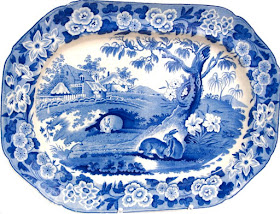 |
| Zoological Gardens by James & Ralph Clews, c. 1830 shows the Otter House |
 |
| Source print for the Otter House is from a children's guidebook to the zoo, c. 1830 |
 |
| Zoological Gardens Pattern Mark |
There has always been an interest in collecting other living creatures with whom we share our planet. Documented pictographic and hieroglyphic records of animals in menageries go back to 2500 B.C. in Saqqara, the ancient burial ground or necropolis of ancient Egypt. But since this is an English transferware blog, I shall focus on animal keeping in England. In the 12th century, King John kept a menagerie at Woodstock, the present site of Blenheim Palace. Henry III, his great-grandson, moved the collection to the Tower of London in 1252, when he was given a gift of several lions or leopards. Gifts of exotic animals were common in ancient times and still are today. Queen Elizabeth II gives her animal gifts to the national zoos. The Menagerie served as a source of entertainment and a symbol of the wealth and power of the monarchy and England for nearly 600 years, from 1252 until it merged with the London Zoological Gardens in 1831.
In the late 18th century there was a shift from keeping animals to studying them. This change came out of expanding European exploration that made exotic wildlife, both flora and fauna, more accessible. There was enthusiasm on the part of amateur naturalists as well as scholars to produce books depicting the new discoveries, catalog different species, and establish societies and zoos. In England, scientific interest in flora and fauna led to the founding of the London Zoological Society in 1826 and the opening of the London Zoological Gardens in 1828 in Regent's Park.
The potters always tried to capitalize on the latest fashion and passion. The London Zoological Gardens was immensely popular, so the Staffordshire potters copied pictures from books and magazines that showed the early zoo. By the way, the word “zoo” didn’t come into popular parlance until the 1840s (obviously a shortened form of the word zoological).
The photos above show a circa 1830 pattern from James & Ralph Clews' (1813-1834) "Zoological Gardens" on an 8 inch plate. It was copied from a children's guidebook called "Henry And Emma's Visit To The Zoological Gardens, In The Regent's Park," by James Bishop, 1830. The plate is part of a large dinner service that includes many other animals and their zoo enclosures.
By the way, this pattern and many others in the series can be seen in the Pattern and Source Print Database of the Transferware Collectors Club. And, the London Zoo is still located in Regent's Park. However, the large animals live outside of London at the Whipsnade Zoo.


































